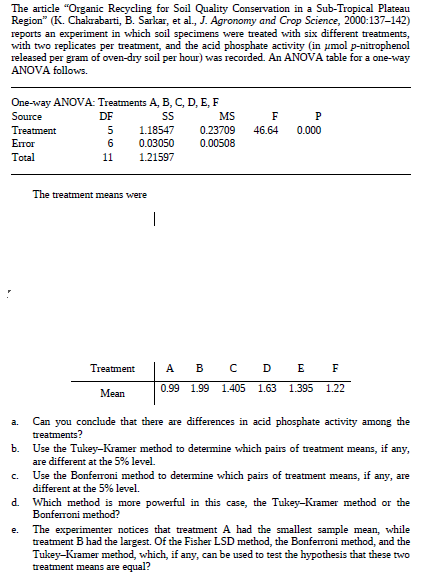The article "Organic Recycling for Soil Quality Conservation in a Sub-Tropical Plateau Region" (K. Chakrabarti, B. Sarkar, et al., J. Agronomy and Crop Science, 2000:137-142) reports an experiment in which soil specimens were treated with six different treatments, with two replicates per treatment, and the acid phosphate activity (in umol p-nitrophenol released per gram of oven-dry soil per hour) was recorded. An ANOVA table for a one-way ANOVA follows. One-way ANOVA: Treatments A, B, C, D, E, F Source DF MS Treatment 1.18547 0.23709 46.64 0.000 Епог 0.03050 0.00508 Total 11 1.21597 The treatment means were А в с D E F Treatment 0.99 1.99 1.405 1.63 1.395 1.22 Mean Can you conclude that there are differences in acid phosphate activity among the treatments? a. Use the Tukey-Kramer method to determine which pairs of treatment means, if any, are different at the 5% level. Use the Bonferoni method to determine which pairs of treatment means, b. if any, are C. different at the 5% level. d. Which method is more powerful in this case, the Tukey-Kramer method or the Bonferroni method? The experimenter notices that treatment A had the smallest sample mean, while treatment B had the largest. Of the Fisher LSD method, the Bonferoni method, and the Tukey-Kramer method, which, if any, can be used to test the hypothesis that these two treatment means are equal? e.
The article "Organic Recycling for Soil Quality Conservation in a Sub-Tropical Plateau Region" (K. Chakrabarti, B. Sarkar, et al., J. Agronomy and Crop Science, 2000:137-142) reports an experiment in which soil specimens were treated with six different treatments, with two replicates per treatment, and the acid phosphate activity (in umol p-nitrophenol released per gram of oven-dry soil per hour) was recorded. An ANOVA table for a one-way ANOVA follows. One-way ANOVA: Treatments A, B, C, D, E, F Source DF MS Treatment 1.18547 0.23709 46.64 0.000 Епог 0.03050 0.00508 Total 11 1.21597 The treatment means were А в с D E F Treatment 0.99 1.99 1.405 1.63 1.395 1.22 Mean Can you conclude that there are differences in acid phosphate activity among the treatments? a. Use the Tukey-Kramer method to determine which pairs of treatment means, if any, are different at the 5% level. Use the Bonferoni method to determine which pairs of treatment means, b. if any, are C. different at the 5% level. d. Which method is more powerful in this case, the Tukey-Kramer method or the Bonferroni method? The experimenter notices that treatment A had the smallest sample mean, while treatment B had the largest. Of the Fisher LSD method, the Bonferoni method, and the Tukey-Kramer method, which, if any, can be used to test the hypothesis that these two treatment means are equal? e.
MATLAB: An Introduction with Applications
6th Edition
ISBN:9781119256830
Author:Amos Gilat
Publisher:Amos Gilat
Chapter1: Starting With Matlab
Section: Chapter Questions
Problem 1P
Related questions
Question

Transcribed Image Text:The article "Organic Recycling for Soil Quality Conservation in a Sub-Tropical Plateau
Region" (K. Chakrabarti, B. Sarkar, et al., J. Agronomy and Crop Science, 2000:137-142)
reports an experiment in which soil specimens were treated with six different treatments,
with two replicates per treatment, and the acid phosphate activity (in umol p-nitrophenol
released per gram of oven-dry soil per hour) was recorded. An ANOVA table for a one-way
ANOVA follows.
One-way ANOVA: Treatments A, B, C, D, E, F
Source
DF
MS
Treatment
1.18547
0.23709
46.64
0.000
Епог
0.03050
0.00508
Total
11
1.21597
The treatment means were
А в с D E F
Treatment
0.99
1.99
1.405
1.63
1.395 1.22
Mean
Can you conclude that there are differences in acid phosphate activity among the
treatments?
a.
Use the Tukey-Kramer method to determine which pairs of treatment means, if any,
are different at the 5% level.
Use the Bonferoni method to determine which pairs of treatment means,
b.
if
any, are
C.
different at the 5% level.
d. Which method is more powerful in this case, the Tukey-Kramer method or the
Bonferroni method?
The experimenter notices that treatment A had the smallest sample mean, while
treatment B had the largest. Of the Fisher LSD method, the Bonferoni method, and the
Tukey-Kramer method, which, if any, can be used to test the hypothesis that these two
treatment means are equal?
e.
Expert Solution
This question has been solved!
Explore an expertly crafted, step-by-step solution for a thorough understanding of key concepts.
This is a popular solution!
Trending now
This is a popular solution!
Step by step
Solved in 4 steps with 13 images

Recommended textbooks for you

MATLAB: An Introduction with Applications
Statistics
ISBN:
9781119256830
Author:
Amos Gilat
Publisher:
John Wiley & Sons Inc

Probability and Statistics for Engineering and th…
Statistics
ISBN:
9781305251809
Author:
Jay L. Devore
Publisher:
Cengage Learning

Statistics for The Behavioral Sciences (MindTap C…
Statistics
ISBN:
9781305504912
Author:
Frederick J Gravetter, Larry B. Wallnau
Publisher:
Cengage Learning

MATLAB: An Introduction with Applications
Statistics
ISBN:
9781119256830
Author:
Amos Gilat
Publisher:
John Wiley & Sons Inc

Probability and Statistics for Engineering and th…
Statistics
ISBN:
9781305251809
Author:
Jay L. Devore
Publisher:
Cengage Learning

Statistics for The Behavioral Sciences (MindTap C…
Statistics
ISBN:
9781305504912
Author:
Frederick J Gravetter, Larry B. Wallnau
Publisher:
Cengage Learning

Elementary Statistics: Picturing the World (7th E…
Statistics
ISBN:
9780134683416
Author:
Ron Larson, Betsy Farber
Publisher:
PEARSON

The Basic Practice of Statistics
Statistics
ISBN:
9781319042578
Author:
David S. Moore, William I. Notz, Michael A. Fligner
Publisher:
W. H. Freeman

Introduction to the Practice of Statistics
Statistics
ISBN:
9781319013387
Author:
David S. Moore, George P. McCabe, Bruce A. Craig
Publisher:
W. H. Freeman